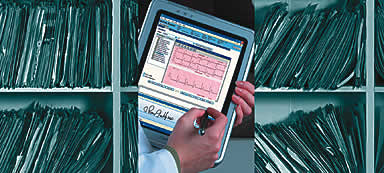|
 Want
to Get to Full EMR? Want
to Get to Full EMR?
No
one disputes that patient care quality and physician satisfaction
will improve when an electronic health record system is in place
where patient medical records can be accessed in a secured system
on a need to know basis by the patient's health care practitioners.
The
software and hardware required to fully implement EMR is readily
available.
The challenge is implementation. Change is never easy. And the move
from a paper blizzard office to paper free is revolutionary and
risky. There is a lot that can go wrong when the change touches
every one and affects every task in a medical practice. It's easy
to understand why an office attempting to go paperless may not succeed.
 QBS
understands the flow of information through a medical practice,
whether paper or electronic and the systems and software needed
to manage, store and retrieve both paper and electronic documents.
Additionally QBS is familiar with setting-up scanning processes
to convert paper to electronic digital format. In short QBS has
the experience and the capability to assist you in developing and
implementing a plan to become a full EMR office. QBS
understands the flow of information through a medical practice,
whether paper or electronic and the systems and software needed
to manage, store and retrieve both paper and electronic documents.
Additionally QBS is familiar with setting-up scanning processes
to convert paper to electronic digital format. In short QBS has
the experience and the capability to assist you in developing and
implementing a plan to become a full EMR office.
We
can help you avoid the pitfalls and roadblocks on the path to becoming
an EMR practice. In analyzing the successes and failures the most
common problems are:
- Failure
to obtain buy-in of the clinical and support staff can doom a
project. There must be a commitment to change evidenced by a belief
within the practice that change must occur for the organization
to survive or to prosper. It's a costly, frustrating and futile
effort if key players aren't willing to use an EMR.
- All
EMR solutions are not created equal; some are more flexible and
user friendly than others. The conversion is more likely to succeed
if the system allows the physicians to practice medicine the way
they are used to.
- A
dated Practice Management Systems (PMS) written in a proprietary
code will limit EMR efficiency and reduce the economic benefits.
A seamless communication between EMR and PMS is required to be
fully effective. The more adaptable EMR systems are Microsoft
Office based while some of the earlier PMS packages were written
in private code and not easily connected to a Microsoft based
EMR package.
- Inadequate
planning can create unexpected roadblocks causing delay and frustration
in implementation. Detailed analysis of existing processes and
developing detailed plans for the new processes may not seem critical,
but without them a workflow change can go undetected until the
system goes operational.
- True
financial rewards must be evident, and not at the expense of patient
care quality. The sooner financial benefits become clear the more
likely there will be successful EMR implementation. Seeing improvements
in workflow and practice efficiency are early indicators that
EMR implementation is on track.
- Too
much, too fast increases the risk of failure. In a fully installed
EMR the practice needs to become completely paperless, including
automating the patient chart, prescriptions, office notes, transcriptions,
lab results and charge capture. All of this can take months to
implement. Risk of failure and cost overruns can be substantially
reduced with incremental implementation.
Are
you ready for full EMR? Call QBS today at (419) 693-2444. Or email
us at qbs@qbsohio.com.

|

 Want
to Get to Full EMR?
Want
to Get to Full EMR? QBS
understands the flow of information through a medical practice,
whether paper or electronic and the systems and software needed
to manage, store and retrieve both paper and electronic documents.
Additionally QBS is familiar with setting-up scanning processes
to convert paper to electronic digital format. In short QBS has
the experience and the capability to assist you in developing and
implementing a plan to become a full EMR office.
QBS
understands the flow of information through a medical practice,
whether paper or electronic and the systems and software needed
to manage, store and retrieve both paper and electronic documents.
Additionally QBS is familiar with setting-up scanning processes
to convert paper to electronic digital format. In short QBS has
the experience and the capability to assist you in developing and
implementing a plan to become a full EMR office.